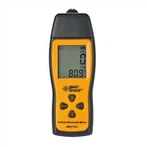Rotor probe for anemometer
The working principle of the rotating wheel probe of the anemometer is based on converting the rotation into an electrical signal. First, through a proximity induction head, the rotation of the rotating wheel is "counted" and a pulse series is generated, and then converted by the detector. Get the speed value.
The large-diameter probe (60mm, 100mm) of the anemometer is suitable for measuring turbulent flow with medium and small flow velocity (such as at the outlet of the pipe). The small-diameter probe of the anemometer is more suitable for measuring the airflow with the cross-sectional area of the pipeline more than 100 times larger than the cross-sectional area of the expedition head.
The positioning of the anemometer in the air flow The correct adjustment position of the rotor probe of the anemometer is that the airflow direction is parallel to the axis of the rotor. When the probe is gently turned in the airflow, the indication changes accordingly. When the reading reaches the maximum value, the probe is in the correct measurement position. When measuring in the pipeline, the distance from the starting point of the straight part of the pipeline to the measurement point should be greater than 0XD, and the influence of turbulence on the thermal probe and pitot tube of the anemometer is relatively small.
The practice of measuring the airflow velocity of the anemometer in the pipeline has proved that the 16mm probe of the anemometer is the most widely used. Its size not only ensures good permeability, but also can withstand flow rates up to 60m/s. As one of the feasible measurement methods, the measurement of airflow velocity in the pipeline, the indirect measurement procedure (grid measurement method) is suitable for air measurement.






